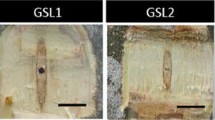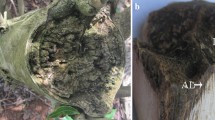Abstract
Agarwood is a non-timber forest product found in tropical rain forests. It is a black and fragrant resin valued for the perfume industry and demand continues to increase. However, the Indonesian agarwood-producing species, Aquilaria malaccensis and Gyrinops versteegii do not automatically produce such quality resin. Bio-induction technology or inoculation using Fusarium solani is usually applied to these species to trigger resin production. This research aims to identify agarwood compounds formed in seedlings and trees of A. malaccensis and G. versteegii after these species were inoculated with the fungus F. solani. The chemical compounds were identified by comparing the patterns of mass spectra fragmentation in the sample and in previous studies. Five groups of agarwood compounds were identified: (1) sesquiterpen group—cis-jasmone and aromadendrenepoxide; (2) chromones group—8-methoxy-2-(2-phenylethyl)chromen-4-one and newly-discovered chromone derivative, 7-(benzyloxy)-5-hydroxy-2-methylchromone found only in G. versteegii; (3) aromatic group—benzylacetone, guaiacol, p-ethylguaiacol, phenol, syringaldehyde, vanilin, furfuryl alcohol, and furfural; (4) fatty acid group—palmitic acid, oleic acid, and lauric acid; and, (5) triterpen group—squalene.







Similar content being viewed by others
References
Baser KHC, Demirci F (2007) Chemistry of essential oils. In Berger RG (ed) Flavours and Fragrances. Chemistry, Bioprocessing and Sustainability. Springer, Heidelberg
Bhuiyan NI, Begum J, Bhuiyan NH (2009) Analysis of essential oil of agarwood tree (Aquilaria agalocha Roxb) by gas chromatography mass spectrometry. J Bangladesh Pharmacol Soc 4(1):24–28
Chen HQ, Wei JH, Yang JS, Zhang Z, Yang Y, Gao ZH, Sui C, Gong B (2012) Chemical constituents of agarwood originating from the endemic genus aquilaria plants. Chem Biodivers 9(2):236–250. https://doi.org/10.1002/cbdv.201100077
Cowan M (1999) Plant products as antimicrobial agents. Clin Microbiol Rev 12(4):564–582
Dharmadasa RM, Siriwardana A, Samarasinghe K, Adhihetty P (2013) Standardization of Gyrinops Walla Gaertn. (Thymalaeaceae): newly discovered, fragrant industrial potential, endemic plant from Sri Lanka. World J Agric Res 1(6):101–103. https://doi.org/10.12691/wjar-1-6-1
Donovan DG, Puri RK (2004) Learning from traditional knowledge of non-timber forest products: Penan Benalui and the autecology of Aquilaria in Indonesian Borneo. Ecol Soc 9(3):3
Faizal A, Esyanti RR, Aulianisa NN, Iriawati, Santoso E, Turjaman M (2017) Formation of agarwood from Aquilaria malaccensis in response to inoculation of local strains of Fusarium solani. Trees 31:189–197. https://doi.org/10.1007/s00468-016-1471-9
Fazila KN, Halim KHK (2012) Effects of soaking on yield and quality of agarwood oil. J Trop For Sci 24(4):557–564
Fraga BM (2013) Natural sesquiterpenoids. Nat Prod Rep 30(9):1226–1264
Gibson IAS (1977) The role of fungi in the origin of oleoresin deposits (Agaru) in the wood of Aquillaria agallocha (Roxb.). Bano Biggyn Patrika 6:16–26
Goff SA, Klee HJ (2006) Plant volatile compounds: sensory cues for health and nutritional value. Science 311(5762):815–819. https://doi.org/10.1126/science.1112614
Gusmailina B, Wiyono TK, Waluyo (2010) Visibility application of penetration method to improve IGW (Inoculated Gaharu Wood) quality. Research Reports, Centre for Research and Development of Forest Products, Forest Research and Development Agency Republic of Indonesia, Bogor
Handa SS, Khanuja SPS, Longo G, Rakesh D (2008) Extraction technologies for medicinal and aromatic plants [editorial]. International Centre for Science and High Technology, Trieste
Ismail N, Rahiman MHZ, Taib MN (2016) Direct Thermal Desorption (DTD) extraction for different qualities of agarwood incense analysis. In: IEEE 12th international colloquium on signal processing and its applications (CSPA2016)
Jia DY, Yi SL (2018) Classification of Hoi-An and Sin-Chew agarwood by component analysis of VOCs released in heat-treated agarwood using TD-GCMS and chemometric methods. BioResources 13(2):2916–2931
Jong PL, Tsan P, Mohamed R (2014) Gas chromatography-mass spectrometry analysis of agarwood extracts from mature and juvenile Aquilaria malaccensis. Int J Agric Biol 16(3):644–648
Kallioinen A, Vaari A, Ratto M, Konn J, Siika-Aho M, Viikari L (2003) Effects of bacterial treatments on wood extractives. J Biotechnol 103(1):67–76. https://doi.org/10.1016/s0168-1656(03)00051-8
Konishi T, Konoshima T, Shimada Y, Kiyosawa S (2002) Six new 2-(2-phenylethyl) chromones from agarwood. Chem Pharm Bull 50:419–422
Kumeta Y, Ito M (2010) Characterization of δ-guaiene synthases from cultured cells of Aquilaria, responsible for the formation of the sesquiterpenes in agarwood. Plant Physiol 154:1998–2007
Lancester C, Espinoza E (2012) Evaluating agarwood products for 2-(2-phenylethyl)chromones using direct analysis in real time time-of-flight mass spectrometry. Rap Community Mass Spectrom 26:2649–2656
Lee SH, Mohamed R (2016) The origin and domestication of Aquilaria, an important agarwood-producing genus. In: Mohamed R (ed) Agarwood: science behind the fragrance. Springer, Hamburg. https://doi.org/10.1007/978-981-10-0833-7_1
Li T, Rosazza JPN (2000) Biocatalytic synthesis of vanillin. Appl Environ Microbiol 66(2):684–687. https://doi.org/10.1128/aem.66.2.684-687.2000
Lin F, Mei WL, Wu J, Dai HF (2010) GC–MS analysis of volatile constituents from Chinese agarwood produced by artificial methods. J Chin Med Mater 33(2):222–225
Mei WL, Yang DL, Wang H, Yang JL, Zeng YB, Guo ZK, Dong WH, Li W, Dai HF (2013) Characterisation and determination of 2-(2-phenylethyl)chromones in agarwood by GC-MS. Molecules 18:12324–12345. https://doi.org/10.3390/molecules181012324
Naef R (2011) The volatile and semi-volatile constituents of agarwood, the infected heartwood of Aquilaria species: a review. Flavour Fragr J 26(2):73–87. https://doi.org/10.1002/ffj.2034
Novriyanti E (2010) Chemical study of agarwood inoculated by Fusarium sp. on Aquilaria microcarpa. In: Siran SA, Turjaman M (eds) Development of agarwood production technology based on community society. Research and Development Centre for Forest and Nature Conservation, Bogor
Qiao LR, Yang L, Zou JH, Li L, Sun H, Si YK, Zhang D, Chen X, Dai J (2012) Neolignans and sesquiterpenes from cell cultures of Stellera chamaejasme. Planta Med 78(7):711–719. https://doi.org/10.1055/s-0031-1298380
Rahayu G, Isnaini Y, Situmorang J (2001) Characteristics of Acremonium isolates from agarwood producing tree: morphology, isozym pattern, and its susceptibility to benomil. In: Purwantara A, Sitepu D, Mustika I (eds) Proceeding of the national congress XVI dan scientific seminar of the Indonesian phytopathological society. The Indonesian Phytopathological Society, Purwokerto, pp 455–461
Rahayu G, Santoso E, Wulandari E (2010) Effectiveness and interaction between Acremonium sp. and Fussarium sp. in agarwood formation on Aquilaria microcarpa Baill. For Inf 7(2):155–164
Santoso E (2014) Bioinduction technology of agarwood producing fungi. In: Susmianto A, Turjaman M, Setio P (eds) Track record of agarwood inoculation technology by forest research and development agency. Forda Press, Bogor
Santoso E (2015) Valuation of cultivation agarwood technology. In: Bismark M, Turjaman M, Setio P (eds) Forda Press, Bogor
Sen S, Dehingia M, Talukdar NC, Khan M (2017) Chemometric analysis reveals links in the formation of fragrant bio-molecules during agarwood (Aquilaria malaccensis) and fungal interactions. Sci Rep 7:44406. https://doi.org/10.1038/srep44406
Sitepu IR, Santoso E, Siran SA, Turjaman M (2011) Fragrant wood gaharu: when the wild can no longer provide. In: Proceedings of Program ITTO PD425/06 Rev. 1 (I): production and utilization technology for sustainable development of Gaharu (Gaharu) in Indonesia, Bogor
Subasinghe SMCUP, Hettiarachchi DS (2013) Agarwood resin production and resin quality of Gyrinops walla Gaertn. J Agric Sci 3(1):357–362
Subasinghe SMCUP, Hettiarachchi DS, Rathnamalala E (2012) Agarwood-type resin from Gyrinops walla Gaertn: a new discovery. J Trop For Environ 2(2):43–48
Tabata Y, Widjaya E, Mulyaningsih T, Parman I, Wiriadinata H, Mandang YI, Itoh T (2003) Structural survey and artificial induction of aloeswood. Wood Res 90:11–12
Taiz L, Zeiger E (2002) Plant physiology, 3rd edn. Sinauer Associates Publishers Inc, Sunderland
Tajuddin SN, Muhamad NS, Yarmo MA, Yusoff MM (2013) Charecterization of the chemical constituents of agarwood oils from Malaysia by comprehensive two-dimensional gas chromatography-time-of-flight mass spectrofotometry. Mendeleev Commun 23(1):51–52. https://doi.org/10.1016/j.mencom.2013.01.019
Takemoto H, Ito M, Shiraki T, Yagura T, Honda G (2008) Sedative effects of vapour inhalation of agarwood oil and spikenard extract and identification of their active components. J Nat Med 62(1):41–46. https://doi.org/10.1007/s11418-007-0177-0
Takeuchi W, Golman M (2002) The identity of Agarwood (Gyrinops, Thymelaeaceae), a new economic resource for Papua New Guinea. SIDA Contrib Bot 20:261–267
Tamuli P, Boruah P, Nath SC (2005) Essential oil of eaglewood tree: a product of pathogenisis. J Essent Oil Res 17:601–604. https://doi.org/10.1080/10412905.2005.9699008
Turjaman M, Hidayat A, Santoso E (2016) Development of agarwood induction technology using endophytic fungi. In: Mohamed R (ed) Agarwood: science behind the fragrance. Springer, Hamburg. https://doi.org/10.1007/978-981-10-0833-7_4
Wu B, Kwon SW, Hwang GS, Park JH (2012) Eight new 2-(2-Phenylethyl)chromone (=2-(2-Phenylethyl)-4H-1-benzopyran-4-one) derivatives from Aquilaria malaccensis agarwood. Helv Chim Acta 95(9):1657–1665. https://doi.org/10.1002/hlca.201200069
Xia JG, Wishart DS (2016) Using MetaboAnalyst 3.0 for comprehensive metabolomics data analysis. Curr Protoc Bioinform 55:14.10.1–14.10.91. https://doi.org/10.1002/cpbi.11
Acknowledgements
This study was funded by the SEAMEO-BIO TROP Indonesia. Then, we appreciate USAID through SHERA Program-Centre for Development of Sustainable Region (CDSR) for facilitating and supporting this research. In addition, we would like to show our sincere gratitude to Prof. Dr. Erdi Santoso and Dr. Asep Hidayat for the new insight and expertise given to this research. The authors are also grateful to Dr. Laura L. B. Graham from Borneo Orangutan Survival, Dr. Achmad Solikhin, and Dr. Evelyn for proofreading this manuscript.
Author information
Authors and Affiliations
Corresponding author
Additional information
Project funding: The work was supported by SEAMEO-BIOTROP Indonesia with a special Grant to Dr. Ulfah J. Siregar.
The online version is available at http://www.springerlink.com
Corresponding editor: Tao Xu.
Rights and permissions
About this article
Cite this article
Aqmarina Nasution, A., Siregar, U.J., Miftahudin et al. Identification of chemical compounds in agarwood-producing species Aquilaria malaccensis and Gyrinops versteegii. J. For. Res. 31, 1371–1380 (2020). https://doi.org/10.1007/s11676-018-00875-9
Received:
Accepted:
Published:
Issue Date:
DOI: https://doi.org/10.1007/s11676-018-00875-9




